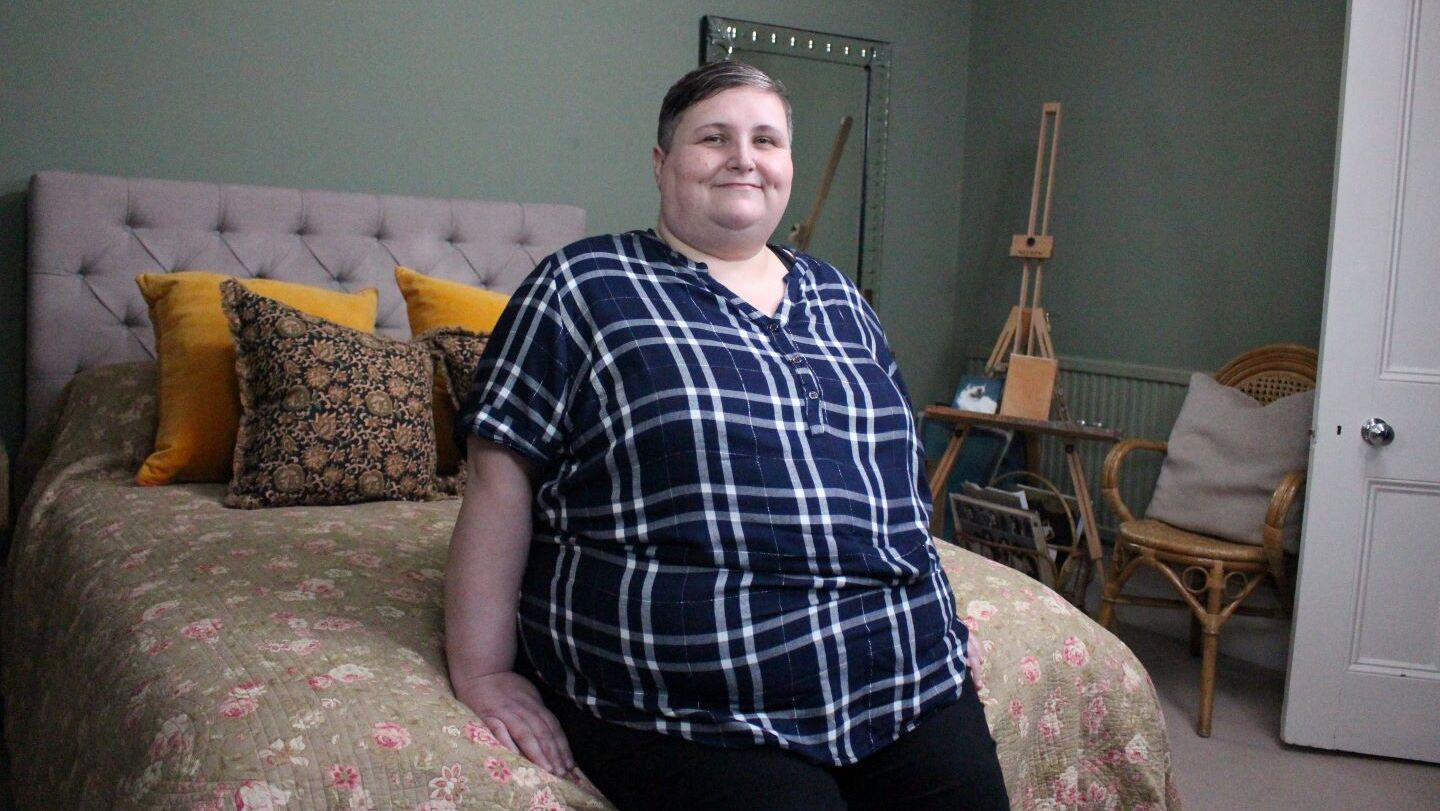Ovarian cancer
Choose a type
What is ovarian cancer?
The ovaries are 2 small, oval-shaped organs in the pelvis (lower area between the hips). They are on either side of the womb (uterus), close to the fallopian tubes. These link the ovaries to the womb. A layer of tissue called the peritoneum supports the ovaries.
About 7,400 women are diagnosed with cancer of the ovary (ovarian cancer) each year in the UK.
The surface of the ovaries, fallopian tubes and peritoneum are very close together. Doctors think most ovarian cancers start in the cells at the end of the fallopian tube and travel to the ovaries or the peritoneum.
Cancers of the ovary, fallopian tube and of the peritoneum are often grouped together because they are so similar. They are treated in the same way.
Ovarian cancer can affect anyone who has ovaries and fallopian tubes. This includes women, transgender (trans) men and people assigned female at birth.
Related pages
Types of ovarian cancer
Epithelial ovarian cancer
This is the most common type of ovarian cancer. It starts in the epithelial cells. There are different sub-types.
Serous is the most common sub-type. At least 8 in 10 (80%) ovarian cancers are serous cancers. They are usually high grade which means they can grow more quickly.
Other much less common types are:
- clear cell clear cell
- endometrioid
- mucinous.
These are usually diagnosed at an earlier stage than serous cancers.
Borderline tumours
Borderline ovarian tumours are also made up of abnormal epithelial cells. But they are not cancer and grow slowly. They may spread to nearby tissue but do not grow in these tissues or spread to other parts of the body.
Related pages
Booklets and resources
Germ cell ovarian tumours
These are rare tumours that start in the ovarian cells that produce eggs. They are not epithelial cancers. Germ cell ovarian tumours usually affect younger people and may be treated differently to epithelial cancer.
Booklets and resources
Symptoms of ovarian cancer
Cancer of the ovary causes symptoms like other more common and less serious conditions. This can make it more difficult to diagnose it early. Symptoms can include a swollen tummy and pain in the back or lower tummy.
We have more information about the signs and symptoms of ovarian cancer.Related pages
Causes and risk factors of ovarian cancer
Doctors do not know what causes ovarian cancer. Different things called risk factors can increase the chance of developing it. For example, getting older or having a family history of ovarian cancer. Having risk factors does not mean someone will get ovarian cancer.
We have more information about the causes and risk factors of ovarian cancer.Diagnosis of ovarian cancer
Your GP asks about your symptoms and does an internal vaginal examination to check for any lumps or swelling. They usually arrange the following tests:
- a CA125 blood test to check for raised levels of this protein, which may be higher in ovarian cancer
- ultrasound scans to check the organs in the pelvis and tummy area.
If the ultrasound shows any abnormal areas, your GP arranges for you to see a specialist doctor (a gynaecological cancer specialist). You should be seen within 2 weeks.
If a GP finds a lump in your pelvis or fluid in your tummy (ascites), they refer you to a specialist straight away.
Sometimes ovarian cancer is diagnosed after being admitted to hospital with a symptom that is making you unwell.
At the hospital
Your specialist doctor will usually ask about:
- your general health
- any previous health problems
- any history of cancer in your family.
They do another internal examination. If you have not had a CA125 blood test and an ultrasound scan the doctor will arrange these tests for you.
Risk of Malignancy Index (RMI)
Your doctor may use your test results to check your Risk of Malignancy Index (RMI) score. This system checks how likely it is your symptoms are caused by cancer.
RMI looks at:
- whether you have gone through menopause
- the levels of CA125 in your blood
- the results of your ultrasound.
Further tests
Your specialist doctor arranges further tests. These help to diagnose the cancer and plan your treatment. You may have:
-
CT scan
A CT scan takes a series of x-rays, which build up a 3D picture of the inside of the body.
-
Removing fluid from the tummy
Sometimes swelling in the tummy is caused by a build-up of fluid. This is called ascites. If you have ascites your doctor may want to take a sample of this fluid and test it for cancer cells. The doctor injects some local anaesthetic into the skin on your tummy to numb the area. They gently pass a small needle through the skin and collect some fluid in a syringe. The fluid is sent to the laboratory to be examined.
-
Biopsy
A biopsy is when the doctor removes a small sample of tissue (biopsy) from the lump or abnormal area. The sample is sent to the laboratory and examined under a microscope.
-
Genetic testing
Your doctor or nurse may talk to you about having a blood test for genetic testing. This is to find out if you have a change (mutation) in the BRCA genes that can cause ovarian cancer. The results help your doctor decide whether certain targeted therapy drugs could be helpful for you.
Waiting for tests results can be a difficult time. We have more information that may help.
Related pages
Staging and grading of ovarian cancer
The stage describes where the cancer started and other areas it may have spread to. Grading describes how the cancer cells look under the microscope compared with normal cells
Your doctor does not usually know the exact stage of the cancer until it has been removed with surgery. If you have not had surgery they use your test results to decide the stage.
Knowing the stage and grade helps your doctors plan the best treatment for you. We have more information about staging and grading of ovarian cancer.
Treatment for ovarian cancer
A team of specialists will meet to discuss the best possible treatment for you. This is called a multidisciplinary team (MDT).
Your cancer doctor and specialist nurse will explain the different treatments and their side effects. They will also talk to you about the things you should consider when making treatment decisions.
The main treatments are:
-
Surgery
You usually have surgery to remove all or as much of the cancer as possible. It usually involves removing the womb, ovaries and fallopian tubes. If you have a very early stage ovarian cancer you may be able to have surgery to preserve your fertility.
-
Chemotherapy
Chemotherapy uses anti-cancer (cytotoxic) drugs to destroy cancer cells. You usually have carboplatin along with paclitaxel. You may have chemotherapy before or after surgery, or both. Sometimes chemotherapy is given on its own as the main treatment if surgery is not possible.
-
Targeted therapies
Targeted therapies target something in or around the cancer that is helping it to grow. You may have a type of targeted therapy called a PARP inhibitor drug. You take it as a tablet for as long as it works for you (maintenance treatment). Another drug called bevacizumab (Avastin®) may also be used if the cancer has spread further in the pelvis.
You may have some treatments as part of a clinical trial.
We have more information about how different treatments are used to treat ovarian cancer.
Treating ovarian cancer that comes back
It can be very hard to hear that the cancer has come back again. You may feel shocked and find it difficult to think of having treatment again. Your doctor and specialist nurse are there to help and support you. They will explain the best treatment options for you. The aim is to control the cancer for as long as possible. Your treatment will depend on:
- the treatment you had before
- how long it kept the cancer away
- if you had any difficult side effects from previous treatments.
You usually have more chemotherapy and a targeted therapy drug. Sometimes further surgery is possible. You may have different treatments over several years to control the cancer. Your doctor may also talk to you about having newer treatments in a clinical trial.
Other cancer treatments are occasionally used:
-
Hormonal therapy
Hormonal therapy may slow the growth of the cancer by blocking or reducing oestrogen. It may be used if the cancer comes back and you do not want more chemotherapy or want to delay it. You usually have it for low-grade cancers. The drugs are the same as those used to treat breast cancer. They include tamoxifen and letrozole.
-
Radiotherapy
Radiotherapy uses high-energy rays to treat cancer. It is not often used to treat ovarian cancer but may be used to control symptoms such as bleeding or pain in the pelvic area. This is called palliative radiotherapy. A type of radiotherapy called stereotactic ablative radiotherapy (SABR) may be used if the cancer is only in one other part of the body, such as a lymph node, or the lung or brain.
Controlling symptoms
Treatments for the cancer often improve any symptoms you have. If the cancer is more advanced you may see a specialist doctor or nurse for expert help in managing symptoms. We have more information about coping with advanced cancer.
Sometimes advanced ovarian cancer causes symptoms because of a build-up of fluid:
- in the tummy (called ascites)
- in the lung (called a pleural effusion) if the cancer has spread to the lung.
Your doctor will arrange to have the fluid drained away. After this you will feel more comfortable and less breathless.
Blocked bowel (bowel obstruction)
If the cancer is growing close to the bowel, it may put pressure on the bowel. This can cause a blockage so the bowel contents cannot easily pass through. Or it may happen because surgery to the abdomen causes tissues to stick together (called adhesions).
Symptoms can include:
- tummy pain
- bloating
- feeling sick
- vomiting large amounts
- constipation
- diarrhoea.
There are different ways it can be managed. Your doctor and nurse will talk this over with you. Treating the cancer may improve a bowel obstruction. But sometimes you may need surgery to remove the blocked section of bowel.
A blocked bowel can also be managed by having fluids through a drip for a time. Sometimes your doctor may suggest having nutrients through a tube, either into the stomach (enteral nutrition) or into a vein (parenteral nutrition).
Related pages
After ovarian cancer treatment
Follow up after treatment for ovarian cancer
After treatment, you will have regular check-ups. These are usually every few months to start with.
If you develop new symptoms or any symptoms you first had come back contact your specialist doctor or nurse. You do not have to wait for a follow-up appointment.
It can take time to work out what feels normal for you. You may worry every ache or pain you have is a sign of the cancer returning. Your specialist nurse can give you support and explain what symptoms to look out for.
CA125 blood test
CA125 blood tests are sometimes done as part of your follow-up. But this is not always needed. A rising CA125 level may be a sign that the cancer has returned. It may mean you need further tests, such as a CT scan.
Doctors usually advise waiting for cancer symptoms to develop before you have more treatment. This is because:
- starting treatment before there are symptoms does not improve treatment results
- you have shorter periods of time between treatments
- you have side effects sooner.
But you and your specialist doctor can start to talk about possible options for further treatment.
Your sex life after ovarian cancer
Cancer and its treatment can cause physical and emotional changes that may affect your sex life. If you have not been through menopause your treatment will usually cause it.
You may also have changes, such as scars or hair loss, that affect your body image. Usually, difficulties slowly improve after treatment. Your nurse can give you more advice.
We need to talk about sex and cancer
We want to encourage more people to feel confident to have open conversations about sex and cancer. Read unique stories, get information and support, and find out how you can talk to someone about sex and cancer.
Well-being and recovery
Even if you already have a healthy lifestyle, you may choose to make some positive changes after treatment. Changes to the way you live such as eating well and keeping active can help your body recover and improve your health and well-being.
We have more information on leading a healthy lifestyle after treatment.
Getting support
Everyone has their own way of dealing with illness and the different emotions they experience. You may find it helpful to talk things over with family and friends or your doctor or nurse.
There are also support organisations that you may find helpful:
- Eve Appeal
Eve Appeal offers information and support for anyone affected by gynaecological cancers. Also provides information about cervical screening and for trans, non-binary and intersex people. Call their helpline on 0808 802 0019. - Ovacome
Ovacome offers information and support for anyone affected by ovarian cancer. - Target Ovarian Cancer
Target Ovarian Cancer offers information and support to anyone affected by ovarian cancer. Call their helpline on 020 7923 5475.
Macmillan can offer emotional, practical and financial help and support. If you would like to talk, you can:
- Call the Macmillan Support Line on 0808 808 00 00.
- Chat to our specialists online.
- Visit our ovarian cancer forum to talk with people who have been affected by ovarian cancer, share your experience, and ask an expert your questions.
Related pages
Booklets and resources
About our information
-
References
Below is a sample of the sources used in our ovarian cancer information. If you would like more information about the sources we use, please contact us at cancerinformationteam@macmillan.org.uk
Ledermann, Raja, Fotopoulou et al. Newly diagnosed and relapsed epithelial ovarian carcinoma: ESMO Clinical Practice Guidelines for diagnosis, treatment and follow-up. Annals of Oncology, 2013; Volume 24, Supplement 6. Updated online 2020. Available from www.esmo.org/guidelines (accessed July 2021)
Management of epithelial ovarian cancer. Scottish Intercollegiate Guidelines Network (SIGN). Nov 2013 revised 2018. Available from www.sign.ac.uk.
-
Reviewers
This information has been written, revised and edited by Macmillan Cancer Support’s Cancer Information Development team. It has been reviewed by expert medical and health professionals and people living with cancer. It has been approved by Chief Medical Editor, Professor Tim Iveson, Consultant Medical Oncologist.
Our cancer information has been awarded the PIF TICK. Created by the Patient Information Forum, this quality mark shows we meet PIF’s 10 criteria for trustworthy health information.
The language we use
We want everyone affected by cancer to feel our information is written for them.
We want our information to be as clear as possible. To do this, we try to:
- use plain English
- explain medical words
- use short sentences
- use illustrations to explain text
- structure the information clearly
- make sure important points are clear.
We use gender-inclusive language and talk to our readers as ‘you’ so that everyone feels included. Where clinically necessary we use the terms ‘men’ and ‘women’ or ‘male’ and ‘female’. For example, we do so when talking about parts of the body or mentioning statistics or research about who is affected.
You can read more about how we produce our information here.
Date reviewed
This content is currently being reviewed. New information will be coming soon.

Our cancer information meets the PIF TICK quality mark.
This means it is easy to use, up-to-date and based on the latest evidence. Learn more about how we produce our information.
How we can help






